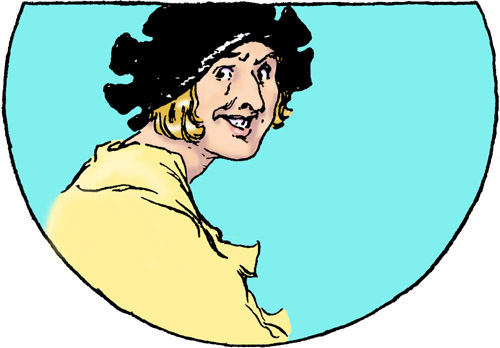Now that The Tin Woodman of Oz is known to be in good working order I think today we shall try to learn a bit about the "white edition" of The Magic of Oz.
The front cover art is quite similar to John R. Neill's original (at right). Dick Martin has modified the "Oz" and other lettering, and added some plant growth behind Dorothy and the Wizard, as well as making more of the magical smoke emanating from the golden bowl on the tripod.
The spine illustration of Loo the Unicorn is loosely based on the drawing of Loo from the chapter heading on page 87, but for the most part this is a wholly new Dick Martin drawing. The back cover, showing the two Li-Mon-Eags, is based on one of Neill's color-plates from the 1919 first edition of Magic. This drawing has been completely redrawn by Martin, which is especially evident in the wings. In many ways I prefer Martin's more vibrant color scheme.
Now, let's open the covers and take a look at the interior of the book.
The "Famous Oz Books" ad (above) is sort of interesting. Dick has cobbled it together using two different portions of the original Tin Woodman of Oz endpapers (seen below).
For a change Dick Martin has retained the original ownership leaf (showing Jack Pumpkinhead), and this is followed by a double page spread showing the original Magic of Oz endpapers from the first edition.
 |
| Endpapers from the first edition of THE MAGIC OF OZ |
One final added detail is the little vignette of the Woozy rolling a hoop after the synopses of the Oz books at the end of the book.
This is taken from the original endpapers of the first edition of Ruth Plumly Thompson's The Giant Horse of Oz (1928).
 |
| Endpapers from THE GIANT HORSE OF OZ |
In addition to his fondness for Oz and Baum, Dick Martin also had a fondness for playing cards and magic tricks. So what better way to end this Magic of Oz blog than with a trick photo (from the early 1960s) showing three Dick Martins playing a magical game of cards with each other.
 |
| Courtesy of The International Wizard of Oz Club. |
Also, at Oz scholar Michael Riley's suggestion, I have added another paragraph to last week's blog on The Tin Woodman of Oz to talk about the Dale Ulrey version. You can revisit that blog by clicking here.
Next week we will journey to the magical Island on Skeezer Lake with Glinda of Oz.















































